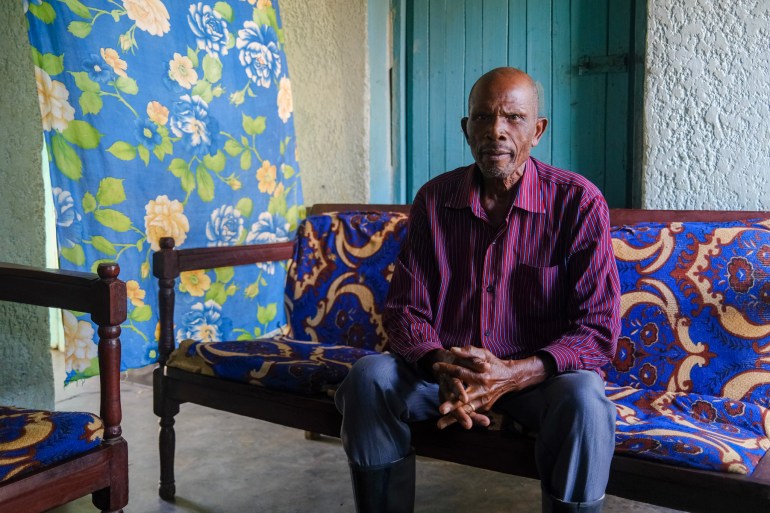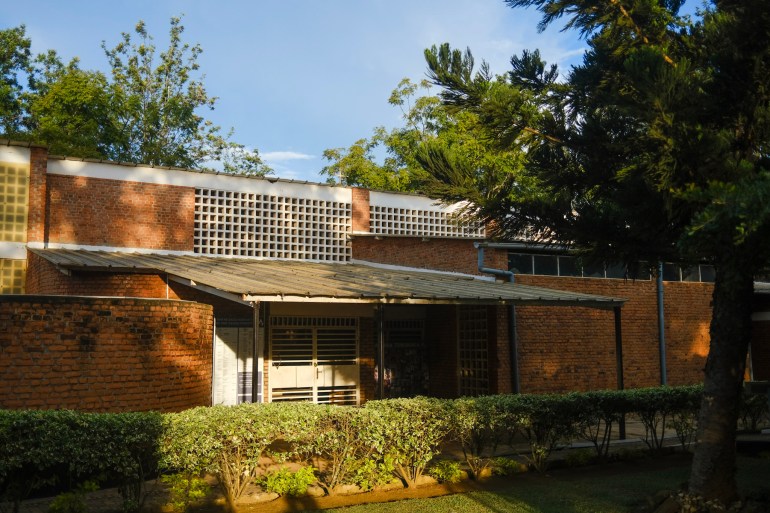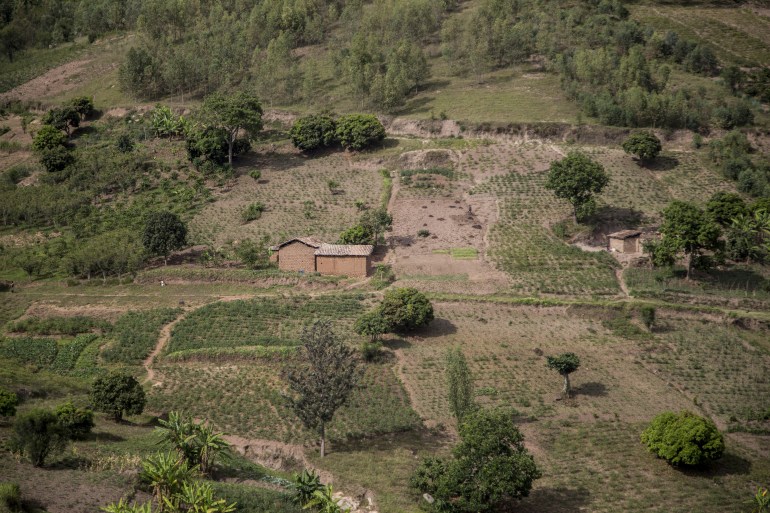Where Rwanda’s genocide perpetrators and survivors live side by side
A man killed his friend’s husband because he was Tutsi. Now he and his victim’s widow live together in a village designed for reconciliation.
![It took years for Laurence to forgive Thacien, a neighbour and life long friend that killed her husband during the genocide [Andrei Popoviciu/Al Jazeera]](/wp-content/uploads/2024/04/reconcilation-village-genocide-popoviciu-couple-1712499335.jpg?resize=770%2C513&quality=80)
Mbyo/Kigali, Rwanda – Mukaremera Laurence gazed at the ground as Nkundiye Thacien spoke about how he used a machete to kill her husband 30 years ago.
The three of them had been neighbours and lifelong friends, living together in the Rwandan village of Mbyo. But then, in 1994, Thacien received orders to kill.
Keep reading
list of 4 itemsMass graves found at Gaza hospital raided by Israeli army
History Illustrated: Gaza, genocide and the world’s most heinous crime
ICJ updates: Nicaragua’s case against Germany over Israel’s war on Gaza
“It was an order and if you didn’t obey they threatened to kill your family,” Thacien told Al Jazeera, “so I felt like I had to do it.”
He speaks about one of the 20th century’s most macabre events, when the majority Hutu group he belonged to, which ruled Rwanda at the time, began a campaign of mass killing against the Tutsis – the minority ethnic group to which Laurence’s husband belonged.
More than 800,000 people – by some estimates, a million – died during 100 days at the hands of machete-wielding Hutus. More than 250,000 women were targeted with sexual violence, according to the United Nations.
Now, Laurence and Thacien live as neighbours in Mbyo, a village that has turned from a killing site to a place practicing resilience and unity. It is one of six reconciliation villages in Rwanda where perpetrators and survivors of the 1994 genocide against the Tutsis live together and attempt to reconcile their past.
“We can’t forget; it’s impossible to forget,” said Laurence. “We live in peace now, but we remember it and always will.”
While their reconciliation story is seemingly one of success, despite criticism of it being artificial, Rwandans continue to struggle with the legacy of the genocide. Many survivors have found solace in learning the truth about how their loved ones were murdered and from apologies from their killers. Others have not found such closure, as new mass graves continue to be discovered and killers’ identities continue to be exposed.

Orders to kill
Ethnic violence had been bubbling in Rwanda for decades before April 6, 1994, but it was on that day that a plane carrying then-President Juvenal Habyarimana and Burundian President Cyprien Ntaryamira, bot was shot down over Kigali. The death of the two presidents, who were both Hutu, led Hutu extremists to blame the Tutsi-led Rwandan Patriotic Front (RPF), a rebel group helmed by current president Paul Kagame, who had been fighting against the ruling Hutus since they took power in 1979. The RPF’s position was that the plane had been shot down by Hutus to provide an excuse to begin killing Tutsis. The Hutus used the flight to revive a long-held belief that all Tutsis needed to be exterminated, convincing the Hutu population in Rwanda to immediately start a campaign of slaughter.
Thacien says that soon after the plane crashed, he heard orders on the newly created Radio Television Libre des Mille Collines station for Hutus to kill all Tutsis – and anyone who protects them – or be killed themselves. The radio messages spewing hate and identifying names of high-profile Tutsis to be targeted were responsible for inciting more than 45,000 killings. The Hutu-run military also spread word on the ground, encouraging violence and organising killing sprees. Thacien joined his fellow Hutus in the killings.
Government forces and Hutu militia groups – together known as Interahamwe, a name that means “those who attack together” – began killing Tutsis in Kigali while also distributing weapons to ordinary Hutus.
Hutus had been preparing to eradicate the Tutsi people for years, explained Thacien, who participated in several Hutu meetings some years before, but “1994 was the official genocide”, he said.
He was 47 when it began. He recalls how people discussed killing tactics and ways to spread genocidal ideologies, while dehumanising the Tutsis by calling them “cockroaches” and “snakes” that needed to be exterminated.
On April 7, Thacien was stationed at main junctions checking identification, which at the time mentioned an individual’s ethnicity, to single out Tutsis to be killed. He also participated in killing parties; one of his targets was Laurence’s husband.
More than a million Hutus joined the movement and used machetes, grenades, guns and other blunt weapons to kill their neighbours, regardless of gender or age, if they belonged to the Tutsi group. Hutus who tried to protect their fellow Tutsis were also targeted.
Places of worship, where people usually found safety, became massacre sites. In the second week of the genocide, thousands – mostly women and children – sought out safety at the Nyamata Church, about 30 minutes from Mbyo.
Hutu militias killed the armed men protecting the church and threw grenades inside and outside its doors. Then the Interahamwe slaughtered the survivors inside with machetes.
Today, evidence of the carnage is still evident throughout the church. There are bullet holes in the roof and the walls. Clothing, coffins and skeletal remains litter the floor. A blood-stained cloth covers the pulpit. In the basement, one floor holds multiple skulls marked by machetes or bullet holes. More than 10,000 people from the church massacre and surrounding areas were buried in mass graves next to the church.

Similar events happened across the country. The massacre ended in July when the RPF, the Tutsi rebel group from Uganda, captured Kigali and overthrew the Hutu government. Its leader, Paul Kagame, became president and continues to rule in Rwanda.
Shocking apology
Many still don’t know who killed their loved ones. Laurence found out in 2003, when Thacien wrote to her from prison and apologised for killing her husband.
The government had adopted a law that reduced prison sentences in exchange for confessions to the killings. To speed up the sentencing of more than one million participants in the genocide, local “gacaca” courts (gacaca means “grass” in the local Kinyarwanda language) were installed as community-led justice systems.
“I felt so bad about it even when I did it, but in prison I knew I had to face my actions,” said Thacien.
When Laurence received the letter and learned that the person who killed her husband was her friend and neighbour, she was shocked.
“It was so hard for me to read the letter,” Laurence told Al Jazeera, “I couldn’t imagine or understand what happened and why.” She worried that the release of prisoners back into the community would put her in danger of again being targeted by Hutu militias.
![A memorial to those who lost their lives during the 1994 genocide in Rwanda stands in the valley that separates two villages on adjascent hills, at the border between Musambira and Nyarubaka sectors of Kamonyi District, on March 4, 2019. Two villages on adjascent hills are re-learning to share all they have, including a well-spring at the bottom of the valley, after 1994 genocide. More than a thousand residents of the town were massacred in the days following the outbreak of inter-ethnic violence, a genocide in which over 800,000 mostly Tutsi people were slaughtered between April to July 1994, according to the UN.[Jacques Nkinzingabo/AFP]](/wp-content/uploads/2024/04/AFP__20190330__1F76DS__v1__HighRes__RwandaGenocideAnniversaryReconciliation-1712500209.jpg?w=770&resize=770%2C513)
Killers and survivors, side by side
After Thacien was released from prison, a local priest organised a meeting so the perpetrators could apologise to the survivors in person. During the first event, people were shy and scared – they didn’t know what to say to each other. At the second meeting, Thacien says he built up the courage and approached Laurence, telling himself, “If she doesn’t forgive me I can’t control that, but what I can do is own up to what I did and ask for forgiveness.”
It took three years, but Laurence did forgive Thacien.
In 2005, they both moved to the Mbyo village, one of six reconciliation villages around the country that were built by a partnership formed between the government and Prison Fellowship Rwanda, an NGO dedicated to helping perpetrators of the genocide reintegrate into society.
The purpose of the villages was to have killers and survivors live alongside each other, while rebuilding their lives and reconciling the past. They also looked to create equality between the two ethnic groups and prevent people from taking revenge for the 1994 genocide.
Government policies also helped to encourage reconciliations, explained Felix Mukwiza Ndahinda, an assistant professor of transitional justice at the Netherlands-based Tilburg Law School and an expert on the Rwandan genocide.
Some of these policies included creating institutions focused on unity and reconciliation and removing ethnicity from personal identification.
Also, it was essentially made illegal to challenge the state’s narrative of the genocide. The government has faced criticism for exploiting history for political gain and has been accused of censorship. Opposition leaders or critics of the government have been imprisoned under the genocide ideology laws, which have been criticised as vague and seen by critics as political tools.
Ndahinda explained that political freedoms in Rwanda need to be examined against the country’s difficult history, genocide legacy and the resulting fracture that made it difficult to imagine how Rwanda could emerge from it. Reconciliation processes are more complex than this narrow frame, he added.
“How individuals engage with one another on the hills, live together in villages, negotiate their daily relations and sometimes choose to marry within families across the survivor-perpetrator divide is beyond governmental doing,” Ndahinda said.

Finding forgiveness
Thacien and Laurence have been living in the reconciliation village for 19 years and remain close. When Thacien’s son got married recently, Laurence attended the wedding.
But not everyone has found peace.
Naphtal Ahishakiye, executive secretary of Ibuka, a genocide survivors’ group, spoke to Al Jazeera from the Nyanza Genocide Memorial site in Kigali’s suburb of Kicukiro, where workers were repainting and trimming grass in preparation for the following week’s commemoration events. He told Al Jazeera that “people are still suffering and many don’t have closure” because many remains haven’t been found and not all perpetrators have been sentenced.
More mass graves are still being discovered. Last October in the region of Hueye, bones were found during a home renovation. This prompted search-and-excavation efforts in the area, which led to the discovery of the remains of more than 1,000 people.
“For 30 years, villagers asked their neighbours to tell them the truth about what happened in the past and no one admitted to anything. Then they found the remains,” said Ahishakiye. “This undermines trust and the reconciliation process.”
A quarter of the genocide’s survivors still struggle with mental health, according to Ahishakiye, who stressed the need for continued support as new generations born after the genocide reach adulthood.
The state can’t control how parents of both perpetrators and survivors communicate with their children in private about the past, Ndahinda pointed out. The Rwandan diaspora, made up mostly of people critical of President Kagame’s approach to governance, also has starkly contrasting views to Rwandans at home – differences that might not be as easy to handle, he added.
![Josepha Mukaruzima, 70 (C), a Tutsi woman from Ruseke village, whose entire family was killed, stands with Jean-Claude Mutarindwa, 42 (L), a Hutu from neighbouring Giheta village, at the border between Musambira and Nyarubaka sectors of Kamonyi District on March 4, 2019. In the 1994 genocide in Rwanda, majority Hutu's from Giheta turned on their long-time neighbours in Ruseke. Mutarindwa was a young man from the village of Giheta. Unlike his brothers, he did not pick up a machete to kill, and that helped him be one of the first to lay the foundation stones for reconciliation. The neighbours are now re-learning to share all they have, including a well-spring at the bottom of the valley. More than a thousand residents of the town were massacred in the days following the outbreak of inter-ethnic violence, a genocide in which over 800,000 mostly Tutsi people were slaughtered between April to July 1994, according to the UN. [Jacques Nkinzingabo/AFP]](/wp-content/uploads/2024/04/AFP__20190330__1F75K8__v4__HighRes__TopshotJosephaMukaruzima70CATutsiWomanFromRuseke-1712498295.jpg?w=770&resize=770%2C513)
“The uncertainty about the future in an environment with pockets of instability remains on many people’s minds,” said Ndahinda.
But while issues still persist for many, often hidden behind closed doors, people like Laurence and Thacien have found a way to accept the past and move on together. Back in the Mbyo village, the two neighbours attend church together, share food and take care of each other’s children.
With tears in his eyes and while holding Laurence’s hand, Thacien said how grateful he is for Laurence’s forgiveness.
“I did something extremely bad and hurt her and her family,” he said, “Now, during the week of commemoration events my only wish is to be by her side. I want to show that I care for her and that I will protect her. I want her to feel safe with me.”